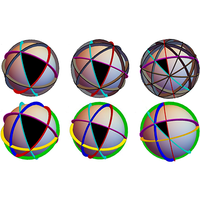ACADEMIA
American University prof builds models to help solve few-body problems in physics

In physics, the conundrum known as the "few-body problem," how three or more interacting particles behave, has bedeviled scientists for centuries. Equations that describe the physics of few-body systems are usually unsolvable and the methods used to find solutions are unstable. There aren't many equations that can probe the wide spectrum of possible few-particle dynamics. A new family of mathematical models for mixtures of quantum particles could help light the way.
"These mathematical models of interacting quantum particles are like lanterns, or islands of simplicity in a sea of complexity and possible dynamics," said Nathan Harshman, American University associate professor of physics and an expert in symmetry and quantum mechanics, who along with his peers created the new models. "They give us something to grip onto to explore the surrounding chaos."
Harshman and his peers describe the work in a paper published in Physical Letters X. Theoretical physicists like Harshman work at the atomic level, aiming to solve the mysteries of the building blocks of life for energy, motion and matter. The new models exhibit a broad array of quantum particle interactions, from stable to chaotic, simple to complex, controllable to uncontrollable, and persistent to transitory. If these models could be constructed in a laboratory, then the control and coherence provided in special, solvable cases could be used as a tool in the next generation of quantum information processing devices, like quantum sensors and quantum supercomputers.
In the last decade or so, physicists have been able to make one-dimensional optical traps for ultracold atoms in the lab. (Only at low temperatures do quantum dynamics emerge.) This led to a flurry of theoretical analyses, as researchers discovered they could make progress on understanding three-dimensional problems by thinking about solutions in terms of simpler, one-dimensional systems.
The researchers' key insight is working in abstract, higher dimensions. The models describe a few ultracold atoms trapped and bouncing back and forth in a one-dimensional trap. The equation describing four quantum particles in one dimension is mathematically equivalent to the equation describing one particle in four dimensions. Each position of this fictional single particle actually corresponds to a specific arrangement of the four real particles. The breakthrough is to use these mathematical results about symmetry to find new, solvable few-body systems, Harshman explained.
By moving particles to a higher dimensional space and choosing the right coordinates, some symmetries become more obvious and more useful. Then, these symmetries can be used to map a system from the higher dimension back into a simpler model in a lower (but abstract) dimension.
Coxeter models, as Harshman calls these symmetric, few-body systems, named for the mathematician H.S.M. Coxeter, can be defined for any number of particles. The particles can have different masses, making them different from previous equations that can only describe particles that have equal mass. In particular, when the particle mass and order are chosen correctly, the system shows integrable (or well-defined) dynamics, which have as many conserved quantities, like energy and momentum, as they have degrees of freedom.
So far, only rarely do solvable few-body systems have experimental applications. What comes next is to implement the Coxeter models in a lab. Harshman and his colleagues are talking with physics experimentalists about how to construct systems with mixed-mass particles as close as possible to integrable systems. As integrable systems allow for greater coherence, the systems they construct could help unravel some of the most complex concepts in physics, like quantum entanglement. Other proposals include using chains solitons (stable clumps of atoms) because the masses of solitons can be controlled in an experiment.
